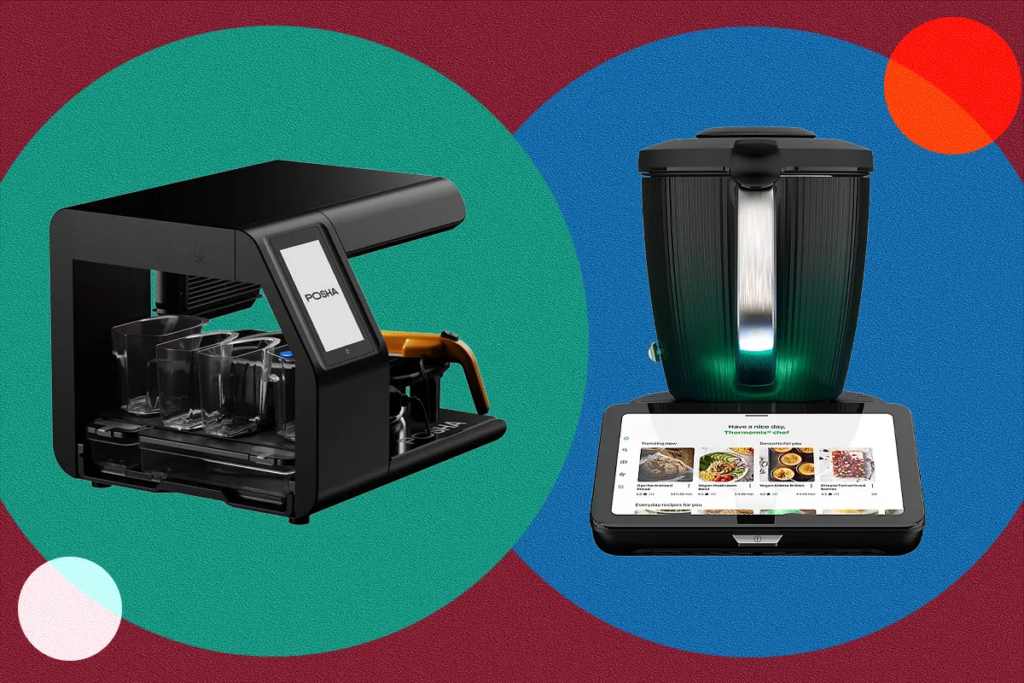The holiday is still almost a week away, and I’m sick of Thanksgiving. I’ve already made four rounds of mashed potatoes, three of mac and cheese, and three turkeys (with more still waiting in my fridge) as part of testing smart probes to help smoke turkeys outside and preparing seven-course holiday meal kits for friends and family.
I was eager to finally outsource some of the cooking by testing two very different robo-chef devices, the Thermomix TM7 and the Posha kitchen robot. Both promise to plan my meals and also do most of the cooking, which sounds pretty good to me.
The Thermomix descends from a German device launched in 1968—a time when the best-known robot chef was cartoon Rosie on The Jetsons—that was essentially a blender with a heater. It’s since caught on big in countries from Italy to Portugal to Australia, and over the years it’s added multi-tier steaming, baking, proofing, a touchscreen, an encyclopedic recipe app, and a whole lot of smart features. WIRED reviewer Joe Ray called 2020’s last-generation Thermomix TM6 (9/10, WIRED Recommends) the “smartest of the smart kitchen.” The newest version, the seventh-generation TM7, was released in August and looks like a giant trophy with a computer screen. It retails for $1,699 and its goal is to replace almost every appliance in your kitchen. It’ll even happily order groceries for you on InstaCart.
The newest robo-chef entrant is Posha, a Silicon Valley-via-Bangalore startup device that aims at truly autonomous one-pot cooking, once you’ve chopped up the proper ingredients into little bins. The Posha kitchen robot was released in January at a price of $1,750 and promptly sold out, as has each successive batch. The device comes complete with a robot stirring arm, and a camera to monitor moisture and browning. Press a button, and Posha will add ingredients at the appropriate moment, spice and stir your food, add water and oil, and cook it down, all without your participation.
I used both the Posha and Thermomix to make a spread of Thanksgiving sides: candied yams, mashed potatoes, mac and cheese, brussels sprouts, and a more complex wild card entry chosen because I thought my Aunt Katherine might like it—and assessed cooking experience overall. Consider it a robo-chef face-off.
Here is my experience with each of the Thermomix and the Posha—and how each fared on five Thanksgiving side recipes.
Cooking Experience With Thermomix
The Thermomix has almost 60 years of history. This is a good thing. It began as, essentially, a blender that can cook. It is still a very powerful blender that can cook. Lord, it makes pesto or mashed potatoes as quickly and easily as anything. I stood by in actual awe of its raw cooking-blending power.
But it’s also evolved into a whole lot more, an all-in-one device that purports to replace just about every appliance in your kitchen. Today’s Thermomix has become a beast of multifarious functionality.
The device will give you a shopping list, weigh out your food, steam on a multi-tiered “Varoma” steaming tray, blend, mix, roast, and proof your bread dough with aid from the device’s Wi-Fi-enabled computer screen. Stacked up, you can make a sauce, a rice bowl, and a steam-grilled salmon all at the same time. The TM7 purports to replace 20 devices, plus presumably a meal kit subscription to boot: You can transfer your shopping list to Instacart, and allow all the food to come to you. Because of the long history, the Thermomix now sports 100,000 well-tested recipes on its “Cookidoo” app, enough to let you try a new dish every meal for 91 years.
But if you’re looking for a fully autonomous robot, that’s not quite what you’re getting. The Thermomix is, instead, a robot that tells you what to do. Maybe the Thermomix is a robot chef, but you’re the prep cook. You will do the chopping. As you follow along on the device’s screen, you drop in each chopped ingredient at the right times—weighing inside the bowl of the Thermomix. Sometimes, the device will just tell you what to put in the oven, and when to do it.
But it’s a beautifully insulated cooking and baking bowl, with some serious power behind it, and some wonderful sophistication in its recipes. Indeed, I cooked one of my favorite meals this year with this device: a walnut squash with roasted vegetables and arugula pesto.
Cooking Experience With the Posha
Posha’s tagline is “See dinner cook itself,” and it largely lives up to this.
You must keep the device lubricated with cooking oil and water in the appropriate reservoirs. You must prep and chop ingredients into four plastic bins on the left side of the machine. And you must load the appropriate spice grenades into a rotating tray that feels like a CD spinner from the 1990s. But once you have done this, the Posha really does just kinda … go.
This is a one-pot cooker, with a proprietary nonstick pan that you can mount with a Robotix-style robot arm that’ll stir or flip your food using one of three spatula configurations. An overhead camera monitors the cook, assessing for moisture and browning, as the device goes through step after step of browning, stirring, adding water, and cooking it back down.
Each recipe does take a lot longer than you think it will—the Posha is a patient device—but you don’t have to do anything while it cooks. You don’t even have to be nearby. Though it’s a bit hypnotic to watch the robot arm spin through your food, you can follow along on your phone app: Posha sends you periodic pictures of what the food looks like.
The name Posha is derived from the Hindi and Sanskrit word for nutrition, and so far a lot of the recipes are also from Indian cuisine: I’ve been enjoying learning Indian cooking one recipe at a time. Even the Chinese dishes are often Indian, with Indo-Chinese staples like Hakka noodles or Gobi Manchurian. I laughed as I noted the machine cook even chicken fajitas—one of a scant few Latin American recipes—with classically South Asian technique, blooming each spice in oil before cooking began in earnest.
Recipes are still limited to about 1,000, each designed by a team of four full-time chefs in response to user recipe requests. The repertoire will expand based on who’s already using it. (And lord, Posha is responsive: If you send a note back on a recipe, you’ll get an email about it. Rate a dish two stars out of five on the device, and you will in fact be asked why you didn’t like it.)
But as with most new tech, it glitches here and there. Not overly often, but sometimes the robot arm isn’t connected as well as it should be, and the device stops working in protest. Once, the ingredient bins simply refused to register with the sensors, and so the recipe halted. Usually, the solution is the same: “Have you tried turning it off and on again?”
But mostly, you can press start and then walk away. Your phone will buzz when it’s done. The device’s website, somewhat hilariously, shows a woman apparently falling asleep with a glass of wine next to the thing.
For readers who are deeply interested in how these devices performed, here’s a rundown of how the Posha and Thermomix each fared on five holiday dishes.
Test 1: Candied Yams
Candied yams is a classic holiday favorite, slow-cooked on a skillet or baked in a casserole dish, slathered in sweet and buttery goodness. The yams I made are, of course, not actual yams. They’re sweet potatoes. But why fuss?
For both devices, I was the prep chef and the dishwasher. I still had to peel and cut up a couple of pounds of sweet potatoes to start, and I still had to clean up at the end.
The Posha was well suited for the task of candied taters. Once I’d peeled and cut the yams, and notched the appropriate quantities of butter, brown sugar, and nutmeg into the bins, the device set to work patiently skillet-cooking the yams to gentle, butter-browned loveliness over about a half-hour. Slow skillet cook-downs are the Posha’s greatest strength, and it’s more patient than I am at attaining a rich and lovely Maillard reaction over low heat.
The Thermomix was great at creating a rich and sticky butter sauce, mixing and heating in a hot bowl, ready to pour over yams. But the actual yam cooking happened in an oven, on sheet trays, once slathered in sweet butter sauce. I always like oven yams less than the skillet version, and that was true here too. While prep remained simple, I still had to use two devices and prepare sheet pans, and the prep time was much, much longer.
Both dishes came out well, but Thermomix’s texture and depth didn’t quite live up to the roasty, candied splendor of the Posha version.
Candied Yam Victory: Posha
Test 2: Brussels Sprouts
Neither device’s app sported a fancy brussels sprouts recipe of the kind that pops up often on Thanksgiving tables in my parts: the walnuts, the maple glaze or honey, the parmesan or chili or lord knows what else. People love messing with brussels sprouts.
But Posha and Thermomix kept it simple. Salt, pepper, and garlic for Posha. Salt, pepper, and lemon for Thermomix. Each cooked a bit differently, however. The Posha, as befits a device that cooks with a pan, cooked up the sprouts to a gentle char over low heat. The Thermomix called for a short steam in the device’s steam basket, then a roast to brown in the main bowl of the TM7.
In the end, the Posha’s sprouts needed a bit of extra time to be done, even after the machine declared them finished—and didn’t live up to the moist, flavorful, near-perfect results attained by the Thermomix. Truly, the TM7 makes a lovely brussels spout.
This said, clean-up was tougher with the Thermomix, requiring a water-vinegar pre-clean cycle and still quite a bit of scrubbing to get the brown bits off the stainless steel interior of the Thermomix’s bowl.
Brussels Victory: Thermomix
Test 3: Mac and Cheese
Up to now, both devices fared pretty well. But the Thermomix fell apart on mac and cheese. I should note that Thermomix’s cutely named Cookidoo app has many recipes for mac and cheese that involve casserole dishes in an oven and look more promising, but I opted for the recipe that cooked the mac and cheese inside the bowl of the Thermomix.
The proportions of water and noodle seemed a little off, and there was no draining step. And the final step, mixing in the cheese, was disastrous. Rather than slowly stir in cheese, the recipe asked me to dump in a big pile of cheese all at once, then stir it in. I dutifully followed advice, against all good instincts, and, of course, a big glob of cheese formed instead. The bowl was not a good container to try to mix the cheese in, and eventually I had to pour it all into a stovetop pan to re-mix properly, by which time the noodles were limp and torn. Alas.
The Posha handles pasta well, by measuring the amount of water needed for a given weight of noodles. A spaghetti marinara was not my favorite sauce recipe (too much dry herb), but the noodles came out al dente. Mac and cheese fared similarly well. I might have favored a different cheese blend, but the noodles were well textured after a long, low-heat cook-down, and the cheese sauce was creamy. Nice work, Posha. It was also the easiest recipe I cooked—in some ways as easy as the Kraft version.
Mac and Cheese Victory: Posha
Test 4: Mashed Potatoes
Now it was the Posha’s turn to fail—or at least be really weird. Posha is a one-pot dish, and it wants to do everything for you. This means no draining the water. It means Posha must add enough water to cook your potatoes, but then cook down all the water before adding butter and milk and mashing. This takes a whole lot of time, at least an hour, and it cooks the dickens out of the potatoes.
By the time the potatoes were boiled, then boiled down, then milked and buttered, then cooked down, then watered for “mashing” with a silicone stirrer, there was no texture left to the potato. The creamy, gluey substance was like the inside of a twice-baked potato, with a whole lot of fat mixed in, like a fried potato puree. I’m not saying it tasted bad, exactly. But I’ve never seen a potato so mercilessly forced to submit.
But the Thermomix was made to make mashed potatoes. When the mashed potatoes were done, I could not believe they were already finished. Fast, effortless, lump-free, airy, creamy. The whole process is the Platonic ideal of making mashed potatoes. Thermomix said to peel them, but I didn’t bother. Still great. 10/10, would mash again.
Mashed Potato Victory: Thermomix
Test 5: Wild Card
In addition to holiday staples, I also picked a dish from each device’s stable of house recipes, based on what just kinda looked good. Something with root vegetables, autumnal and stately.
From Posha, I leaned into its Indian-cuisine strengths but kept it mild for the aunts and cousins. And so I selected a dish called carrot poriyal, a gentle dish from Tamil Nadu made with carrots and toasted coconut and a Madras spice mix that includes mustard seed and savory herbs. And also a tiny bit of green chili, but no worse a bite than black pepper.
This was a delight, actually, both in terms of ease of prep and the resulting dish. The coconut was nicely toasted, but so was the carrot, browned lightly and cooked in with layers of spice and wilted leaf. I’d serve it happily to my family, and when I finished cooking, I assumed this dish would be the victor. (Actually, every Indian dish I’ve had with the Posha has been lovely, and usually better than the Punjabi restaurant down the street. But note that sourcing of some ingredients, such as curry leaves, can be difficult depending on where you live.)
Then I had the walnut squash from Thermomix. I picked it as the height of New Englandy WASP Thanksgiving—not just a squash medley but a pesto squash medley, almost hilariously Martha Stewart in its buttoned-up vision of luxe.
The pesto happened so fast it didn’t feel real. The Thermomix shakes and bangs like a bag of rocks when it blends up a bunch of nuts, but my pesto was near-immediate and beautifully done, whipped into dense flavor. (The recipe was vegan, and called for vegan parmesan. I used the real stuff.) But the squash prep was laborious, in that it involved splitting and peeling and cubing multiple varieties of squash or sweet potato—then baking them on sheet pans.
When the final dish came together, I forgot all the prep, the same way I’m told mothers forget the pain of childbirth the moment a newborn baby is placed into their arms. Lord, this was good. Why was this so good? Texture! Contrast! Lots of fat! Earthy depth, lemony brightness. This was the real thing—the side I am now obligated to bring to my family.
Upon tasting it, a colleague who used to work as a high-end line chef paused in admiration. “We would have served this at the restaurant,” he said.
Wild Card Victory: Thermomix
Which Is Better, Posha or Thermomix?
Based solely on the cooking results, the Thermomix wins—not just in three out of five dishes, but also based on the long-tested tens of thousands of recipes, developed over years and generations and in dozens of countries. The Posha has some serious catching up to do on the culinary front.
But the Posha is also easier to use. Cook times on average came out a little shorter with Posha—largely because the Thermomix sometimes relies on long oven bakes. The difficulty rating on each Posha recipe averaged out to a mere two out of 10. It’s an ambitious device, one that performed far better than I expected despite being such new technology, and a little more realistic as an automated home cooking device than an Optimus or a Rosie in every kitchen. (I do not have room, nor inclination, to have a metallic, human-sized thing puttering around.)
Average Scores Over 5 Recipes
But at the same time, the Posha has that new-tech smell. It has myriad possible break points, occasional glitchiness. It is a work in progress, a nest of firmware updates. Pre-orders are also backed up months (though you need to pay a mere $25 to “hold” a pre-order). And while the Thermomix is tried and tested, the Posha’s longevity is unknown. The Posha is a leap of faith, one that not everyone will want to make. And money aside, the counter space alone is quite the investment.
If I had to buy one or the other, similarly priced devices this year? I’d choose the dogged, proven reliability of the Thermomix, which has the added benefit of fitting in a cabinet when I’m not using it.
But next year may be different. Posha already works better than I’d have reason to expect. And after seeing the speed and responsiveness of Posha’s customer service, and spending some time with Posha CEO Raghav Gupta during a device demo, there’s reason to be optimistic about Posha’s future, both as a device and a company. I saw also his plans for the next generation of Posha—that someday, it would be mounted above your stovetop, not hulking mountainously on your counter.
I don’t know who will win the robot wars of the future. But as it stands right now, I’m not betting against Posha.
The post Posha vs. Thermomix: Kitchen Robots Face Off on Thanksgiving Sides appeared first on Wired.




